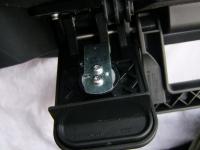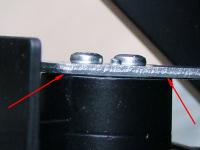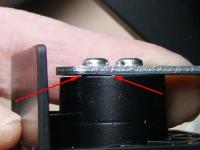mcatrophy
Privileged to ride a 2018 FJR1300AS
There have been several posts about the stiffness of the bag locks, with various inputs on lubricants or whatever to try to free them.
I had a bit of an issue with my first FJR's locks, but a periodic spray with thin oil was usually sufficient to keep them tolerable.
My new FJR was much worse in this respect (though better in many other ways). I've stripped down the locks a couple of times, cleaned them and used oil or PTFE spray lubricant, which helped a bit, but never stopped them being too stiff.
So I had another go to find out exactly what was causing the problem. It turns out the metal plate was rubbing quite hard on the plastic.
(Click on any image for larger view)



The arrows in the third pic show where it rubs.
So I undid the screws, then put thin washers between the metal plate and the lock barrel, so leaving a small gap between the plate and the plastic.

The washers I used were stainless to avoid corrosion, but probably a little too thick, the lock feels fairly loose (but doesn't affect its security at all).
At least my key won't bend!
If you do try this, be very careful not to drop the washers into the works, they just disappear (don't ask how I know). I used a little dob of Vaseline to hold the washers in place while I put the screws in.
Oh, yes, the "book" says use Loctite. (I didn't; nor did I on my first, my calibrated wrist seems able to do the screws up sufficiently to stop them loosening, but use your own judgement
 .)
.)
I had a bit of an issue with my first FJR's locks, but a periodic spray with thin oil was usually sufficient to keep them tolerable.
My new FJR was much worse in this respect (though better in many other ways). I've stripped down the locks a couple of times, cleaned them and used oil or PTFE spray lubricant, which helped a bit, but never stopped them being too stiff.
So I had another go to find out exactly what was causing the problem. It turns out the metal plate was rubbing quite hard on the plastic.
(Click on any image for larger view)



The arrows in the third pic show where it rubs.
So I undid the screws, then put thin washers between the metal plate and the lock barrel, so leaving a small gap between the plate and the plastic.

The washers I used were stainless to avoid corrosion, but probably a little too thick, the lock feels fairly loose (but doesn't affect its security at all).
At least my key won't bend!
If you do try this, be very careful not to drop the washers into the works, they just disappear (don't ask how I know). I used a little dob of Vaseline to hold the washers in place while I put the screws in.
Oh, yes, the "book" says use Loctite. (I didn't; nor did I on my first, my calibrated wrist seems able to do the screws up sufficiently to stop them loosening, but use your own judgement



